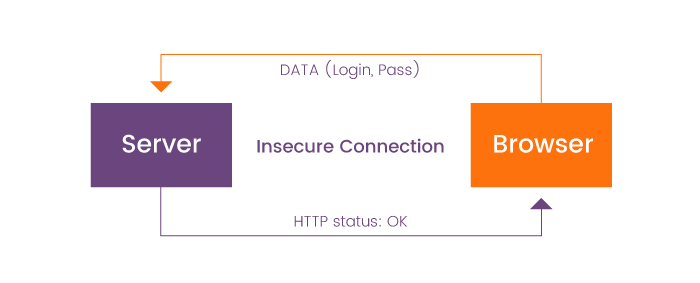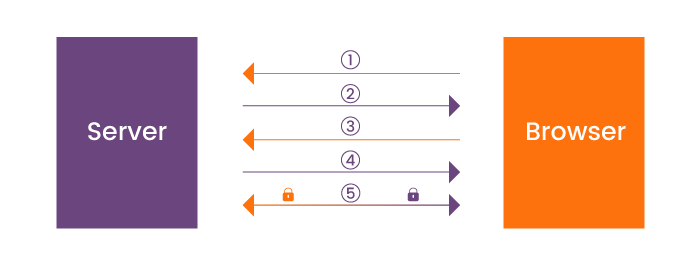-
Product Management
Software Testing
Technology Consulting
-
Multi-Vendor Marketplace
Online StoreCreate an online store with unique design and features at minimal cost using our MarketAge solutionCustom MarketplaceGet a unique, scalable, and cost-effective online marketplace with minimum time to marketTelemedicine SoftwareGet a cost-efficient, HIPAA-compliant telemedicine solution tailored to your facility's requirementsChat AppGet a customizable chat solution to connect users across multiple apps and platformsCustom Booking SystemImprove your business operations and expand to new markets with our appointment booking solutionVideo ConferencingAdjust our video conferencing solution for your business needsFor EnterpriseScale, automate, and improve business processes in your enterprise with our custom software solutionsFor StartupsTurn your startup ideas into viable, value-driven, and commercially successful software solutions -
-
- Case Studies
- Blog
HTTP vs HTTPS: How to Secure Your Site With SSL
Back in August of 2014, Google officially announced it would use HTTPS as a ranking signal due to security issues.

Google’s move means that migrating your website from HTTP to HTTPS can give you a minor boost in search results. So the short answer to why your website should use HTTPS over HTTP is because Google favors it.
For most companies, Google’s recommending HTTPS is reason enough to make the switch, but all the same we believe that it’s important to know what both protocols mean, what the difference between HTTP and HTTPS is, and what the advantages and disadvantages are of each option. We’d like to begin with an overview of the HTTP protocol and then take a look at why Google wants websites to move away from it.
What is HTTP, how does it work, and why isn’t it secure?
HTTP, which stands for HyperText Transfer Protocol, is a 15-year-old method for transmitting information across the internet. HTTP is the protocol on which the world wide web was built. This protocol works according to a client–server model, as do many other internet protocols. A web browser initiating an HTTP request is called as the client, and the web server that responds to that request is called the server.
Let’s say you’re sitting in a cafe and trying to log in to your lovely Facebook profile over the local network, e.g. the cafe’s Wi-Fi (for this example, we’ll assume that Facebook is still using HTTP). The cafe’s Wi-Fi network is public, and anyone who connects to it can access the data being transferred across it. Now let’s take a look at what’s happening with your data when a website is using HTTP. By data, we mean everything including your login and password for your Facebook account.

To log in to a website (like Facebook), you need to enter your login credentials (generally your email or phone number and your password). As soon as you click the login button, your data is sent to the server. When the server received your data, it validates it. If everything is correct, the server sends an HTTP status of “OK,” and you are logged in to your account. Easy breezy. Everything seems okay.
But here’s the problem – if your data was transferred over HTTP, then it was sent unencrypted via an insecure connection (HTTP doesn’t use encryption), and so any data transferred with the HTTP protocol is out in the open and can be intercepted or even manipulated by third parties. You’ve probably never heard about a network sniffing attack, but such kinds of traps do exist.

Sniffing is a type of attack that hackers use to capture your sensitive network information such as passwords, account information, credit card numbers, users IDs, etc. To accomplish this, hackers usually use sniffer, an application that can capture network packets. Sniffers are also known as network protocol analyzers, but while network analyzers are essentially network troubleshooting tools, hackers can skillfully use them for nefarious purposes.
If network packets aren’t encrypted (in our example, a packet includes your login ID and password for your Facebook account), the data within this network packet can be read using a sniffer. Sniffing is about capturing network packets, and once a packet has been captured using a sniffer tool, the contents of the packet can be analyzed. In this way, hackers can steal your sensitive and private information.
As we can see, the HTTP protocol has one big weakness – the information transferred via HTTP between your device and a web server isn’t encrypted, and theoretically can be intercepted by a hacker at any time. This disadvantage of HTTP may not seem like a big deal for people visiting purely informational websites. But it creates obvious troubles when dealing with personal information used in online shopping and banking. The security concerns with HTTP, however, can be easily solved by using a secure communications channel known as HTTPS.
HTTPS can also protect you from such hacker attacks as man-in-the-middle attacks, DNS rebinding, and replay attacks – but so as not to confuse you, we’ll continue by describing how HTTPS works and how it can protect you from the sniffing attacks we described earlier.
What’s HTTPS and how can it secure your website?
HTTPS is an internet communication protocol that keeps any kind of data, including your passwords, text messages, and credit card details, safe while in transit between your computer and the server(s) you’re sending this data to. In short, HTTPS is just a secure version of HTTP: the “S” at the end literally stands for “Secure.” HTTPS keeps your data confidential by using the Transport Layer Security protocol (TSL), frequently referred to as SSL (Security Sockets Layer). But what is an SSL certificate?
SSL is secure certificate that offers three layers of protection: encryption, which means that all data sent between a browser (client) and a website (server) are encrypted so that even if data are stolen or intercepted a hacker won’t be able to decrypt them; data integrity, which guarantees that your data cannot be modified or corrupted during transfer without being detected; and authentication, which verifies whether you are actually communicating with the intended website. To make sure your communications are safe, you can look for a special green padlock in your browser’s URL bar that indicates whether or not a website is secure.

Let’s look now at how SSL encryption works and how it can protect your data from sniffers. We’ll continue with the same scenario as before, where you’re trying to log in to your Facebook account with your email and password. Remember that this time you’re logging in to Facebook over an HTTPS connection that is secured by an SSL certificate.
SSL certificates use what is known as asymmetric Public Key Cryptography, or a Public Key Infrastructure (PKI) system. A PKI system uses two different keys to encrypt communications: a public key and a private key. Anything that is encrypted with the public key can only be decrypted by the corresponding private key and vice-versa.
Note that the private key, as its name suggests, should be kept strictly protected and should only be accessible to the owner of the private key. With a website, the private key must be kept secure on the web server. Conversely, the public key is intended to be distributed to anybody and everybody that needs to be able to decrypt information that was initially encrypted with the private key. Now that we understand how public–private key pairs work, we can move on to describing how SSL certificates work. We’ll split this process up into several steps to make it easier to follow.
How does the SSL certificate work?
Step 1. Establish a secure communication between the server and the browser by means of a handshake. The handshake process starts when the browser makes a URL request (for instance, when you enter "https://www.facebook.com/" into your address bar). By sending this URL request, the client initiates a secure SSL connection between the client’s browser and the server transmitting communication options such as version and type of encryption. The client’s sending a request to initiate an SSL connection is called a client hello.
Step 2. The next step is called a server hello. Having received the client’s request, the server responds by sending a copy of its SSL certificate along with its public_key, thus completing the client hello process.
Step 3. As soon as the client receives this data back from the server, the browser verifies whether it implicitly trusts the certificate or whether the certificate can be verified by one of several Certificate Authorities (CAs) that the browser does implicitly trust. This method works because each browser has a pre-installed list of trusted SSL certificates from Certificate Authorities (CAs) that you can view, add, and remove. These certificates are controlled by a centralized group of security organisations including Symantec, Comodo, and GoDaddy. If a server presents a certificate from the browser’s list, then it knows that the website can be trusted. While verifying an SSL certificate, the browser also creates a unique symmetric public_key using the public_key sent by the server. At this point our data are finally encrypted.
Step 4. Then server sends back a signed acknowledgement. Upon receiving this acknowledgement, the server and client initiate an SSL encrypted session. This is how SSL provides authentication.
Step 5. Now that an SSL session has been established, the client and the server can share previously encrypted data safely. The symmetric key that was created during this process is unique to the particular SSL session, and can be used to encrypt/decrypt data exchanged between the client and server during that session.

Using an HTTPS connection secured with an SSL certificate gives you all the protections we mentioned earlier. You get authentication, so you can know that you’re communicating safely with the intended server. You get data encryption, so that even if a sniffer intercepts and steals a network package that includes the public_key, they’ll never be able to decrypt it. And of course you get data integrity, so you can transfer your confidential data without worrying about their been corrupted or modified without your detecting it.
Does my website need an SSL certificate?
Before you make the decision whether to use HTTPS instead of HTTP, we’d like to sum up the major benefits for your website of HTTPS (along with SSL protocol) instead of HTTP:
- Security. All the information that you and your customers transfer to and from your website are encrypted and verified (ensuring data integrity). This saves you from a number of potential hacking attacks such as sniffing, man-in-the-middle, etc. and provides your business with a baseline of security.
- Trust. While more about physical factors, people feel better doing business with a website that cares about the security of their confidential information. HTTPS and SSL help websites to build trust in their business relationships.
- SEO. Even a minor search engine ranking boost will help users find your website.
At RubyGarage, we recommend that all new websites use HTTPS. If your website is already built, you can migrate from HTTP to HTTPS, but you don’t necessarily have to right this moment. If you’re interested in getting a new or current website working with HTTPS, we can assist you with the whole process from buying a certificate to ensuring that incoming HTTP links continue working properly.











